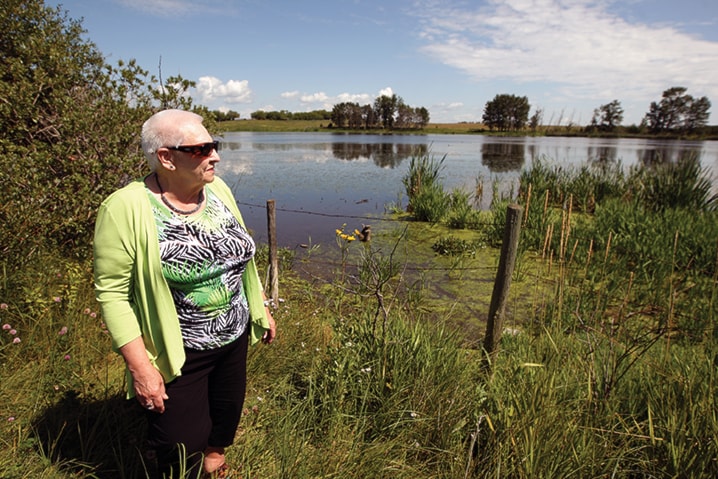Hundreds of migratory birds could be killed or injured if AltaLink crosses a small lake north of Innisfail with new transmission lines, some area naturalists say.
“It’s such a travesty for this to happen… The lake is a place for birds,” not power lines, said Bernice Stewart, a birdwatcher who visits the spring-fed pond, known locally as Cook Lake, almost daily.
She’s seen a multitude of feathered creatures at the spot on the east side of Hwy 2, about 25 km south of Red Deer, near the top of Antler Hill. This includes coots, teals, blackbirds, herons, ducks, geese and bald eagles. Stewart said birds stop to feed or rest at the lake, and sometimes raise their young there.
Even endangered trumpeter swans and pelicans are known to make migratory stops at the lake in the spring.
But starting this fall, AltaLink is expected to begin a $51 million substation project that will channel more electricity to the Innisfail area. Stewart said power lines will cross the 700-metre long water body, dividing airspace above it in two: “The lake runs north and south, and the transmission line is expected to go east-west… I believe it will intersect it close to the middle.”
Bisecting a migratory flightpath with electric lines creates a hazard, added Stewart. She believes many of the birds will fly into the wires, and the “natural sanctuary” will no longer be appropriate habitat.
AltaLink received approval for this route from the Alberta Utilities Commission in 2014 after extensive public consultation. Stewart admitted her concerns come late in the process, but only because she didn’t previously realize Cook Lake would be affected.
Crossing the lake was not AltaLink’s first-choice route. However, the company’s preferred route would have gone through woodlands and raised much opposition from Innisfail residents, therefore the AUC decided to approve the second-choice route instead.
Jack and Audrey Daines, whose property contains the lake, appealed this decision on environmental grounds. “Right from the start, my concern was for the birds,” said Audrey. But their request to quash the approval was denied. The AUC concluded that environmental impacts could be mitigated.
Scott Schreiner, AltaLink’s vice-president of communications, said it’s not uncommon for power lines to cross water, so his company takes measures to reduce its impact on nature. “AltaLink was the first utility in Canada with an avian protection program, designed to reduce the impact of our facilities on the bird population.”
Studies have shown most birds can avoid the thicker, lower wires, but often fly into the thinner, upper one because they can’t see it until the last minute, added Schreiner.
To prevent this, AltaLink installs “bird diverters” on the thinner line (called shield wire) to make it more visible.
Types of diverters include thick coils that be looped over the shield wire at regular intervals, or striped, reflective flag-like markers that hang off the thin wire. Schreiner said these have been shown to reduce bird contact with power lines by 80 per cent.
But Stewart doesn’t feel this is the answer. She said waterfowl have to circle the lake several times before making their descent and the transmission line will cut across their landing strip. “Big birds, especially, need all the space they can get.”
While there are no more legal avenues to go down, she hopes area residents will contact the company, the AUC, and their local MLAs to demand the transmission line be re-routed around the lake instead of across it.
The problem with changing things, at this point, said Schreiner, is that any diversion would mean having to go back to the AUC for a new approval and starting the public consultation process over again.
Construction on the project was already pushed back to this fall instead of starting in July, as expected, because more engineering work had to be completed on the approved alternate route.
